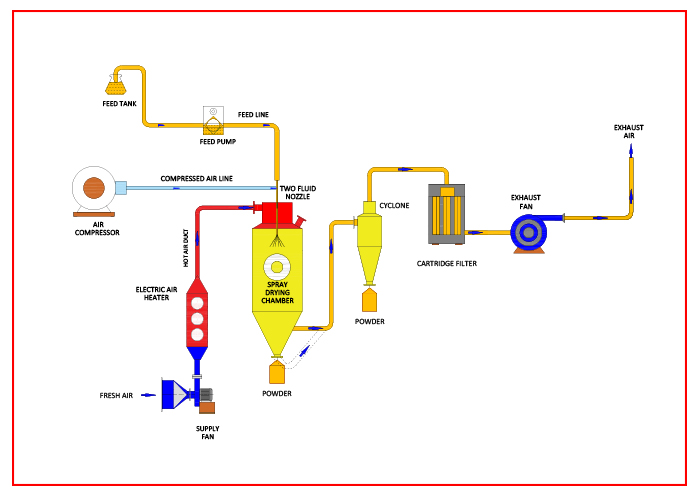Spray Drying solutions for R & D and Production
Mumbai, Maharashtra
Monday to Saturday

Spray drying is the process of transforming a liquid feed into a dry particle form by spraying it into a hot drying medium. When the fluid is a flammable solvent or the product is oxygen-sensitive, an inert gas, such as nitrogen, acts as a drying medium.
Pharmaceuticals spray drying - Overview
Spray drying is the most popular procedure in various sectors to generate tiny particles, coarse powders, agglomerates, or granulates. The features of the particles created by this process are controlled, and their qualities can be kept constant during a continuous operation. The spray drying pharmaceuticals technique produces a product that can quickly meet the product parameters which are most desirable for further processing or application. As a result the pharmaceutical industry uses it to handle primary medications such as APIs and finished pharmaceutical formulations.
Spray drying pharmaceuticals Phases
In the Pharmaceuticals spray drying process, there are three key steps. In a drying chamber, the feed is first atomised into a fine spray. The fine feed spray then comes into touch with a hot gas flow, causing spontaneous liquid evaporation and the formation of dry particles. A cyclone and a filter plays an efficient task to separate the dry particles from the gas. The input and the hot drying gas flow might be co-current, mixed-flow, or counter-current when mixed during atomisation.
Spray dryer pharmaceutical excipients production
The production of pharmaceutical excipients with appropriate qualities is done with spray dryers. Direct compression of powders in solid dosage forms like tablets have better compressibility.
Encapsulation
Nanoparticles and microcapsules manufacturing process with therapeutic cores and biocompatible cover materials uses Spray-drying technology. It helps to build unique controlled drug delivery systems.
Increasing bioavailability
Spray drying in pharmaceutical industry can boost the dissolution rate and solubility of poorly soluble medicines. This usually happens due to the synthesis of pharmacological inclusion complexes or the generation of solid dispersions.
Excipients or APIs
The spray drying procedure can give a dried product favourable property for further processing, such as direct compression. They are converted into free-flowing granules with a combined solid-state of amorphous and crystal shape during the drying process. The resulting distinctive internal structure can give the dry powder good plasticity and binding during the direct tableting. Apart from APIs, excipients can also be spray-dried to achieve some of the following properties: better flowability, adhesion or agglomeration for tableting, and wettability in water.
Dispersion of solids
To achieve desired functionality for final pharmaceutical formulations, APIs are frequently co-spray dried with various excipients. Spray drying for solid dispersion may be one of the most common uses of this method in the pharmaceutical business. Melt-quenching or Spray drying are two of the most well-known methods for dispersing weakly water-soluble medicinal compounds into solid dispersion carriers. However, when compared to melt-quenching, spray drying can prevent the thermal degradation of medications or carriers since the solvent evaporates quickly and the dried product is exposed to a low temperature.
Microencapsulation
In the spray dryer pharmaceutical industry, microencapsulation is used to stabilise active molecules, hide the bitter taste of the medication component, or provide modified-release pharmaceutical formulations. The active medicinal ingredients can be encapsulated by a polymer coat using the suitable excipients and feed solvents. The feed can be an active substance-containing emulsion, suspension, or polymer solution.
Masking the taste
A taste-masking coating for bitter medication ingredients will almost probably increase patient compliance. When creating an orally administered tablet for this sort of medicine, taste masking is essential. Companies make use of spray drying to create taste-masked particles for the highly bitter medication ondansetron hydrochloride.
Heat-sensitive materials drying
Furthermore, due to the cooling impact of rapid solvent evaporation, spray-drying of heat-sensitive materials is possible. As a result, the temperature of the final product is much lower than the drying air's exit temperature. Although more protein inactivation occurred at high inlet drying air temperature, the decreased residual moisture level of the spray-dried powder gave excellent storage characteristics.
Dry powder for inhalation
Spray drying possesses a unique particle engineering feature, so it has a clear benefit over milling to produce dry powder for inhalation. In contrast to other formulations, the particle properties of dry aerosols are particularly significant. They govern the dry aerosols' lung deposition efficiency and consequently their therapeutic efficacies. There are other supercritical fluid technologies with multiple features like crystal engineering, spray freeze drying, electrospray. However, spray drying is still the most widely used method for producing dry aerosol formulations in the pharmaceutical industry.

Head of Innovation
Lorem Ipsum is simply dummy text of the printing and typesetting industry. Benenatis mauris. Vestibulum ante ipsum primis in industry, logistics, finance, business orci ultrices venenatis mauris.
Marketing
92%
Marketing
82%